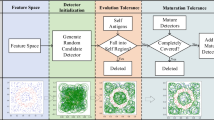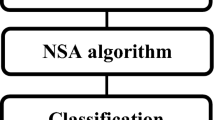Abstract
T-cell-dependent humoral immune response is one of the more complex immunological events in the biological immune system, involving interaction of B cells with antigen (Ag) and their proliferation, differentiation and subsequent secretion of antibody (Ab). Inspired by these immunological principles, a Multilevel Immune Learning Algorithm (MILA) is proposed for novel pattern recognition. This paper describes the detailed background of MILA, and outlines its main features in different phases: Initialization phase, Recognition phase, Evolutionary phase and Response phase. Different test problems are studied and experimented with MILA for performance evaluation. The results show MILA is flexible and efficient in detecting anomalies and novel patterns.
Similar content being viewed by others
Acknowledgments.
This work is supported by the Defense Advanced Research Projects Agency (no. F30602-00-2-0514) and National Science Foundation (grant no: IIS-0104251). Senhua Yu would like to thank his wife Fang Li for her comments and encouragement on this work.
Author information
Authors and Affiliations
Corresponding author
Rights and permissions
About this article
Cite this article
Dasgupta, D., Yu, S. & Majumdar, N. MILA – multilevel immune learning algorithm and its application to anomaly detection. Soft Comput 9, 172–184 (2005). https://doi.org/10.1007/s00500-003-0342-7
Published:
Issue Date:
DOI: https://doi.org/10.1007/s00500-003-0342-7




